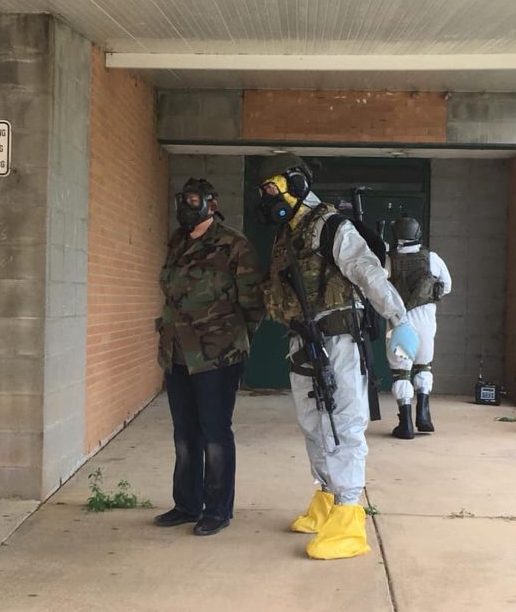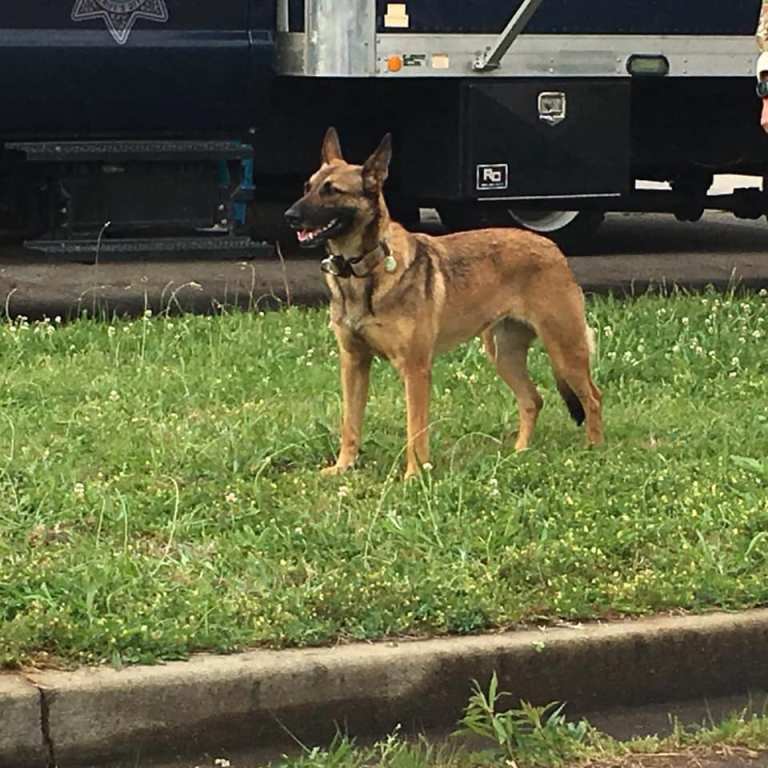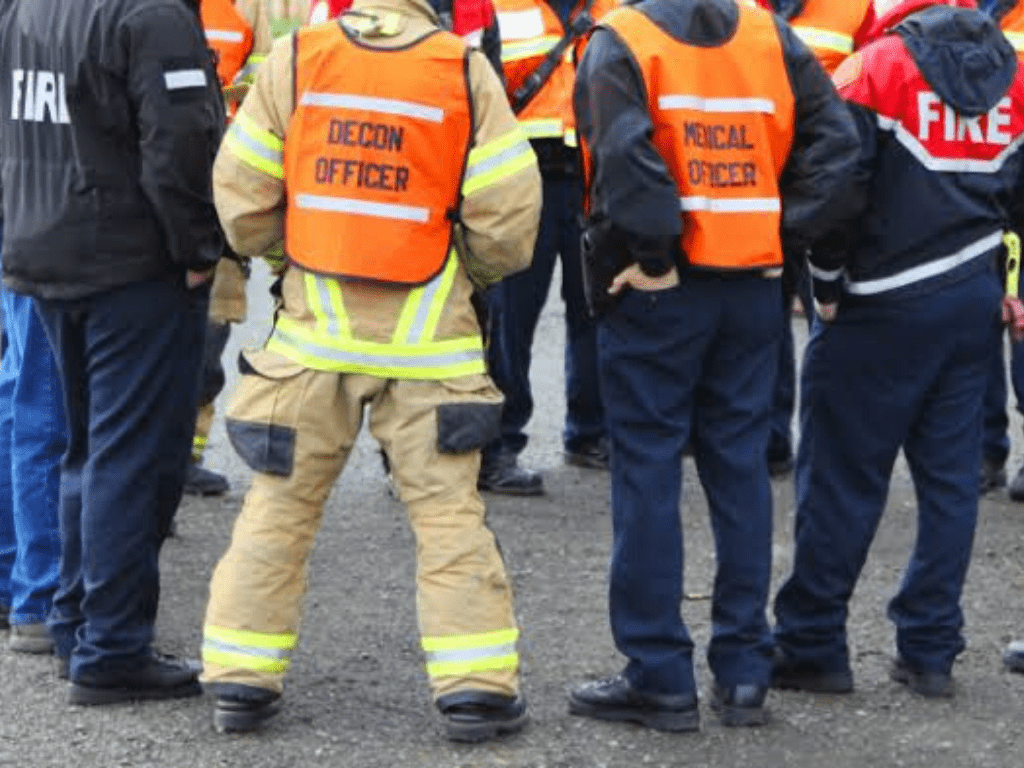
Decontamination for Law Enforcement Operations
When we look at the scope of various hazardous materials operations, the last thing most team members want to be assigned to is the decon section of the haz-mat branch. Let’s face it, why would we want to stand around and wash people off? Decontamination is by no means where we should put our best players, or should we? Law enforcement decon is unique and reinforces why decon should be considered a priority.
When selecting your decontamination leader, who comes to mind? Often times we see in training or classes the newest person will be thrown into this task, or more times than not, the laziest one who goes where the least amount of work is. What most incident commanders fail to see is that in fact, the decontamination leader is one of the most important roles in the operation as a whole. They have a tremendous workload and responsibility in the overall success of the incident ranging from emergency decon, to post operation decon for members exiting the hot zone. Some of the duties the decontamination leader is involved in should include:
- Identify personnel and equipment operating on scene that have the potential to be exposed to any type of hazardous material(s) during the duration of the incident, in addition to the primary hazards, and nature of the incident
- Identify the cold, warm, and hot zones of the incident with the incident commander, and safety officer to direct members of the decon section on the proper location for the decontamination reduction corridor
- Establish emergency decontamination zones, to be utilized in the event of a major exposure or other equipment failure, this should also include an emergency decontamination zone for civilians who may disregard directions from responders on scene.
- Identify the entry team leader, safety officer, and Rapid Intervention Team (RIT) staging locations, in addition to the incident command post location as it correlates with the decontamination reduction corridor, and emergency decon location to avoid exposure to any other personnel not involved in the direct handling of hazardous materials
- Assist in the preparation of the site safety plan (ICS Form 201) as well as maintain or assign a scribe to complete ICS Form 214 (Unit Activity Log) to record the movement of people, equipment, and track special items such as firearms, money, personal belongings, etc
- Confirm with the research officer on scene in regards to appropriate PPE for decontamination personal to use for the decontamination operation, as well as appropriate decontamination measures to ensure that exposed personnel are decontaminated as effectively as possible.
These are just some of the bare bone essentials that must be done for the leader of the decontamination section. Would you still want the newest member or the laziest person on the team to be assigned to this role, and expect them to fulfill these above mentioned priorities in a timely manner? The decon leader is one of the most under respected operators on an incident, because more times than not, you will not reach the operational period on the day to day single or double company responses, but what happens when you throw a twist into the average day to day call? Let’s venture outside the “normal” decontamination operation where we aren’t just decontaminating other technicians, or a few exposed civilians. Does your agency have a contingency response plan for our law enforcement counterparts? At an initial thought, law enforcement decon should be a simple thing! We are Haz-Mat Technicians, Firefighters, Paramedics, And any other title you want to throw on, so will they trust me as a potential stranger (if my team doesn’t regularly interface with them) and hand me their duty weapon, baton, OC spray, spare magazines, or even their K9 counterparts! Why wouldn’t they trust a stranger with their duty weapon? Just think, would you hand your firearm over to a stranger on a busy city sidewalk if you had to bend over and tie your shoes? No? Exactly! You wouldn’t feel safe handing over something that could potentially end your life to a stranger, so why should they? In this next segment, we will explore what you, and what your local law enforcement agencies need to know to avoid conflict or potential spreading of an exposed item on the scene of a hazardous materials incident.
Law Enforcement Decon
We will use the following example for the decon process: 4 Officers respond to a welfare check at a residence after a neighbor reports seeing 2 small children in dirty clothing, malnourished, with one child having a noticeable infection that is very visible, with one child appears to have scarring from some type of burns while out playing in the yard. The neighbor also reports a strange chemical odor from the house, and an extremely high amount of vehicle and foot traffic to the residence. 4 local law enforcement officers responded to the residence, and encounter the children at home alone, and locate a clandestine meth lab which is visible through an open door. Once inside investigating, an officer bumps into a table knocking a bottle of some type of brown liquid on his pants, and his duty belt. They then remove the children from inside the house, and outside. Once outside, both children appear to have suffered injuries consistent with those associated with clandestine lab operation accidents. A local haz-mat team is dispatched to handle mitigation, and other activities associated with the lab. 2 officers are now reporting that they are feeling dizzy, and one begins to vomit. Their supervisor arrives and advises all 4 will need to be transported to the hospital for evaluation. Once EMS arrives, they inform the law enforcement officers that they will not transport anyone on scene until all parties have been deconned. A supervisor then instructs you, as the haz-mat officer, to decon the officers and children as quick as you can. How will you do it? Let’s look at a few points and discuss this:
Why is law enforcement decon different than anything else we have to decon?
Law Enforcement Officers (Further referred to as LEO) may unknowingly be exposed to hazardous materials or contaminated during the operations they are involved in. Oftentimes many LE agencies will conduct operations alone, or in parallel with other law enforcement agencies due to their nature which often requires details to remain unavailable to the general public. They often say, the fastest way to get a secret around is tell a fireman.These operations can range from clandestine labs, to chemical exposures. Law Enforcement operations as a whole often require a certain level of “secrecy” if you will, to allow the incident to remain discreet. This issue was addressed by a haz-mat team administration when a local sheriff’s office approached the team commander to determine a way to involve that specific haz-mat team in certain law enforcement operations that required all personnel involved to not disclose sensitive information in order to hold the case in line for prosecution at its conclusion.
The team administration then consulted with its members to seek a resolution on how it could ensure a commitment to refrain from disclosing sensitive information to the public. At the conclusion, it was determined that all members both current and future, were to undergo a full police background investigation as if they were applying for a sworn law enforcement position. Once they were cleared by the lead law enforcement agency that responded to the same countywide jurisdictional area, a portal was created with secure log in, to share a common pool of information disseminated by the state’s office of homeland security.
This now created a “level” playing field which opened information sharing across the board on issues from narcotics to counterterrorism activities within the state that had the potential to become a response hazard. This also allowed the haz-mat team to attend a new series of classes hosted by the state’s law enforcement academy, as well as other federal training partners much like those available to the fire/ems/hazardous materials side of the business at locations such as the CDP in Anniston, AL and SERTC in Pueblo,CO. There is an extremely large wealth of information available to haz-mat teams through law enforcement training venues that is not commonly shared due to the regard of information sharing reaching the wrong hands. Does information sharing sometimes fall in the wrong hands? Of course. But, usually these training agencies place a general restriction on who can attend. Check with your local law enforcement training officer to see if there are any classes that you, or your team may be eligible to attend. Who knows, it may just save a life.
Law Enforcement officers, regardless of career status, are instructed to NEVER surrender their firearm(s) at all cost. If they do, it could result in deadly consequences. This should be taken into consideration when preparing to conduct decon on LEOs post entry. Establishment of a clearly labeled, and well defined procedure should be implemented well before an incident occurs. This should be broken down into 5 clearly defined sections. Equipment Doffing and Segregation, Wash & Rinse Decontamination Stations, Personal Protective Clothing/Equipment Removal, K9 officer decontamination, and Post Entry Operations Medical Evaluation.

Law Enforcement officers, regardless of career status, are instructed to NEVER surrender their firearm
With these points in mind, how can we address the issue? This is still a sore topic to many, but for the sake of discussion, let’s assume your agency will allow the creation of a SOG, and implement a training session on law enforcement decontamination. The first 3 skill sets are adopted procedures from the Federal Bureau of Investigations (FBI).
- Equipment Doffing and Segregation
- After the decontamination zone has been determined, it is then a transitional phase into establishing a multi phase decon system, working basic principles of decon into a formal plan. These activities should be listed in the ICS 214 form for managing activities and data logging. The decontamination officer should oversee the entire process with little interaction. With this system, 3 stations should include: A wash station to include decon solution/rinsing station, Equipment drop, and PPE removal to follow with a medical assessment.
- The initial station reached will be the wash and rinse station, with equipment drop for various items to follow. This is similar to a tool drop for normal haz-mat operations. When law enforcement officers arrive to the wash and rinse station, firearms will remained holstered, and all equipment worn in the contamination zone will remain on their person. The equipment drop is important to have set up as a clear work space, such as a table to allow them to remove all duty related equipment when instructed.The decon unit should have name tags, or assign numbers/letters for officers undergoing the decon process. These items should be unique to the officer, as all of the officers personal belongings will need to be tracked much like a chain of custody for evidence.
- Wash & Rinse Decontamination Stations
- Once in the wash and rinse station, LEO’s will be washed, and rinsed from head to toe, just as if it were a normal decon operation. Officers will be deconned with the appropriate solution, and rinsed as needed to get the general contaminants off, in order to move forward in the process. This station is utilized to remove the general contaminants, and will allow other items (flashlights, radios, handcuffs, etc) to be deconned further at an appropriate station.
- Personal Protective Clothing and Equipment Drop/Removal
- Once an officer enters the next phase of the process, the next step will be to remove the officers protective clothing, such as an outer carrier (or other type of vest utilized by their agency), their duty belt, and weapon(s). There should be a bucket for small items (Handcuffs, Baton, Flashlight, Keys, and other items that are generally water resistant), a second bucket for any electrical items such as a body camera/mic, watches, notepads, cellphones, etc) to be deconned in an area that will minimize water exposure, and a bucket for duty weapons such as a handgun, rifle, or to hold tasers and cartridges. This will allow for the officers essential equipment to be in one central location for tracking and cleaning.
- A number or letter is then assigned to an officer. The officer, if able, should first clear their firearm(s), and then be handed an item such as an oversized zip tie, or other agency approved device that would prevent the firearm from chambering. (Often times agencies will insert a zip tie, and attach a water resistant name tag to aid in tracking the firearms progress.) This device should be inserted through their weapon to visually show the weapon has been cleared. It is extremely important to insert a restricting device in the event the weapon is dropped, or handed off due to an emergency action during the decon process to prevent questions or assumptions that the firearm may be loaded. The magazine and chambered round shall be placed in the firearm bucket, and transferred to the appropriate location with the firearm it was removed from. By clearing the firearm, this will allow for it to be thoroughly washed/rinsed until it can be cleaned by a contract agency. A decon member should be assigned to each bucket, and decon items in that bucket accordingly to ensure it is cleaned. One agency observed deconned an officers equipment, and placed it in a tote sealed off with evidence tape and an evidence log was placed on top, with the tote secured in a law enforcement transport unit to be redistributed at the law enforcement center after officers were cleared for duty. Once the general decon process is complete, they will continue to move to the next step. Remember, this is a confusing process for both sides, and especially for law enforcement as they do not routinely practice the decon process! It is imperative to avoid confusion, by clearly labeling which step is next in the process, whether it be with numbers, letters, or other labeling systems as to which station to enter or proceed towards in the event of a critical failure during decon, or to avoid general confusion, and patiently working through the process. Officers will then move to the next station, to be deconned after having their equipment removed. This secondary wash will allow for any spots covered by equipment to be deconned, and allow for complete washdown.
- Clothing/Uniform Drop
- After an officer has completed the decon process, it is time to direct them into a sheltered/covered area (Between 2 apparatus with tarps, or tents with side coverage) to allow them to change from their contaminated uniform, into other clothing. This could be another uniform in their vehicles, clothing from their agency brought to the scene, or gowns/other provided PPE to allow them to continue to the medical assessment on site, or to be transported by EMS. It is often found that most officers will have a spare set of clothing, for events such as this or other hazards at work, and would prefer to be in a uniform vs other provided PPE. The same process will occur, with their clothing placed into an evidence bag, sealed and labeled until it can be cleaned by a contracting agency, or department policy. Remember, clothing materials can often hold contaminants, and allowing the officers to leave in the same clothing worn in the decon process will simply make the entire operation a waste, if they get in their patrol vehicles dirty.
- K9 Officer Decontamination: An often overlooked situation in the decon process is who/how will K9 Officers be deconned, in addition to their handler? Through training, and decon processes it has been found that K9 officers are inseparable, and can even take the decon process as an attack on their handler when being brushed, and rinsed off. Therefore, it should be known that the handler and K9 should walk through the process as one unit, and allow the handler to decon the K9 with a brush, and appropriate solution approved for use on dogs, with guidance by a decon team member to ensure the K9 is as best washed as possible. This will allow for the officer to wash the K9 with provided materials, and eliminate any chance of a decon member from being bitten. The handler should then remove the K9’s harness, leash, and any other items and place them in an equipment drop bucket for decon, attached to his or her other equipment for tracking during the incident. The K9 should then be washed a second time, just as the above process listed for a human officer to ensure any other contaminants are removed. It is then recommended that an uncontaminated collar and leash be brought to the handler to be placed on the K9. The K9 can then be passed to a fellow K9 handler and secured in a vehicle or other location, and allow the handler to undergo the full decon process.
This essentially completes the decontamination process, while there may be more specific steps that may need to be added based on the situation, this is a general overview for general law enforcement decontamination. It is important to explain the decontamination process prior to conducting it through training with your local agencies, and conduct a dry run to allow them to see and understand the entire process. By building these relationships pre-incident, it will allow for a smoother process overall, when it does occur. This applies to all fields, and industries, that pre-established relationships provide unity when an incident does occur, and will help your team become better prepared for the unknown.



